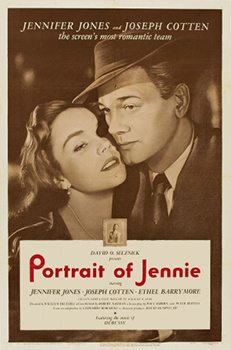| Portrait of Jennie | |
|---|---|
 Movie poster | |
| Directed by | William Dieterle |
| Screenplay by |
|
| Based on | Portrait of Jennie by Robert Nathan |
| Produced by | |
| Starring | |
| Narrated by | Joseph Cotten |
| Cinematography | Joseph H. August |
| Edited by | William Morgan |
| Music by | Claude Debussy Dimitri Tiomkin |
Production company | |
| Distributed by | Selznick Releasing Organization |
Release date |
|
Running time | 86 minutes |
| Country | United States |
| Language | English |
| Budget | $4 million [1] |
| Box office | $1.5 million [1] |
Portrait of Jennie (also released under the title Tidal Wave) is a 1948 American supernatural film directed by William Dieterle, produced by David O. Selznick, and starring Jennifer Jones, Joseph Cotten, Ethel Barrymore, and Lillian Gish. Its plot follows an impoverished New York City painter whose chance encounter with an old-fashioned young woman in Central Park changes the course of his life. It is based on the 1940 novella of the same name by Robert Nathan. [2] [3]
Contents
- Plot
- Cast
- Production
- Development
- Filming
- Music
- Release
- Home media
- Reception
- Box office
- Critical response
- Accolades
- Adaptations
- See also
- References
- Sources
- External links
At the 21st Academy Awards, it won an Oscar for Best Special Effects (Paul Eagler, Joseph McMillan Johnson, Russell Shearman and Clarence Slifer; Special Audible Effects: Charles L. Freeman and James G. Stewart). Joseph H. August was also nominated for the Academy Award for Best Cinematography (Black-and-White).